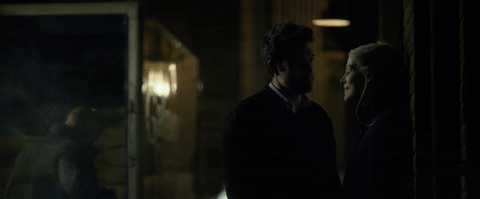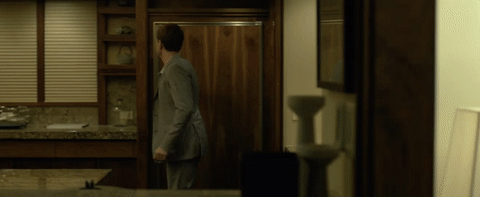by Connor Brousseau
While watching David Fincher’s Gone Girl for the first time, I was shocked on how much I empathized with Ben Affleck’s character Nick, despite all the evidence stacked against him. I realized that this was because Nick was the audience’s introduction into the world. His presence brings the audience into the story, and he propels it forward. We see everything that happens in the narrative (not in a flashback) through his point of view, until the latter half of the movie. We see his mistakes and indiscretions, but the one thing we don’t see as an audience is his violent nature, outside of the flashbacks. His actions within the context of the present narrative, no matter how slimy or despicable, never turn towards violent or threatening. This kept me from taking full stock in what the diary described in David Fincher’s cut of the film.
Through this re-edit of Gone Girl, I will be exploring the film’s themes of emotional manipulation by cutting Gone Girl into a more manipulative narrative. In order to do this, I rearranged the footage into five separate acts. The first act contains all of Amy’s diary entries- detailing the beginning, rise and eventual destruction of Amy and Nick’s relationship- at the very beginning of the film. Nick’s entire narrative takes place during act two and three, the act break taking place where the main plot twist is revealed. The fourth act is Amy’s story after the twist, and the final act is the conclusion of the film. Through this, I hope to be able to more effectively manipulate the audience, the same way Amy and Nick manipulate the American public.
Act One: Painting a Backdrop
The first act of my re-edit of Gone Girl contains all of Amy’s diary entries. All of the evidence against Nick is in the diary. Watching the film unfold through Amy’s eyes first, instead of Nick’s, makes his seemingly understandable behavior throughout act two seem downright villainous. I had no problem believing Amy’s story when we see her entire side of the argument before the events of the film actually begin. We are charmed by Nick, just as Amy is, which makes his descent into an abusive husband that much more tragic for Amy. When the theatrical cut of the film introduces Nick, he is a beaten down man who is exasperated with his wife; an every-man who is easily relatable. In this version the transition from perfect boyfriend to abusive husband is frightening to watch, because it is sudden and believable.


Even Amy’s typeface is manipulative, a factor I didn’t notice until the footage was back to back. The first entries look as though they were written by a teenaged girl, and the later entries look to be written quickly, and without any thought on making them look cute. Even her writing is evidence that Nick is frightening her.



Through this diary, we are being manipulated in the same way that Amy manipulates the cops to be on her side. Much like the American public who observes the media, the audience is put into a position where they cannot hear Nick’s side of the story. By the time they can hear Nick’s side, they have already made up their mind. Act One of my revised version of Gone Girl more effectively does to the audience, what Amy does to the American public.
Act Two: Back to the Start
Just like that, the 20th Century Fox titles appear. We’ve just been dealt a 17 minute prologue with all evidence pointing towards Nick. We are then treated to our first sample of narration not given by Amy. Nick’s voice is heard, atop a shot of Amy’s head.

Not a flattering picture painted towards Nick Dunne. Throughout act two, we witness the evidence stack up against Nick. Even his own actions, like having a secret mistress and smashing a glass in a fit of rage help to incriminate him in the eyes of the police. He innocently smiles while at a press conference for his missing wife, and the media interprets it as sinister.


Act two is where the looming presence of the media comes more into play. We see that public perception changes very quickly, when they’re ready to lynch someone. Like the mob that formed to destroy Frankenstein’s Monster, the people of the community are ready to all but hang Nick when Amy’s friend Noelle asks him at a public event, “what have you done to your pregnant wife?” As Amy muses later, “America loves pregnant women.”


Act Three: Bad Press
Whoever said there’s no such thing as bad press has never seen Gone Girl. Nick’s lawyer, Tanner Bolt says, “We’ll need to realign the public’s perception of Amy.” Everyone in America thinks Nick Dunne murdered his wife. Even the police officers are manipulated by the media. Lead Detective on the case, Rhonda Boney seems to be the only good cop in the outfit, while her partner James is swayed easily by an entertainment reporter on the news.
Nick goes on television as per Tanner’s request in order to realign the public’s perception of himself first. It works, and a quick google search tells him that the public sides with him. Nick’s victory is short lived however, and he is soon arrested after the murder weapon is found in his fireplace.
Act three ends with a mob of angry people around Nick’s car. He’s been released on bail and is preparing for trial. No matter what happens, the public perception of Nick can’t change without more manipulation from Amy.

Act 4: Gone Girl
In Act Four, Amy manipulates the audience as much as she can with the limited resources she has been given. Unfortunately for her, the audience knows all of her tricks now, so the manipulation falls flat. That is, until we are introduced to Desi Collings, an old boyfriend of Amy’s. When Amy gets into a bind she calls Desi for help. He sets her up in his lake house, and immediately takes an uncomfortable amount of control over her. Despite what we have just seen her do, Amy successfully uses her fragile femininity and Desi’s overbearing and inherently creepy nature to manipulate us more.


We also get to finally see Nick’s tv interview. (This is a scene that I cut out of act 3, due to the amount of reaction shots of Desi and Amy.) We see Nick do to Amy what she has been doing to America and the audience for the whole movie. He shows her that he can be the man she wants him to be again, and he asks her to come home. Nick’s charm works, and Amy leaves Desi, cutting his throat during sex and inflicting wounds upon herself conducive to rape.

Act Five: Run Right Back
Amy returns to Nick, crashing a car into his lawn. When she meets him in front of the house, she faints dramatically. This is indicative of what we see throughout all of Act Five. Amy’s manipulation, from the viewpoint of someone who knows that she’s faking everything.

Rhonda, the lead detective on Amy’s case attempts to question her, citing the evidence that doesn’t corroborate with her revised story. Amy simply pretends that she is emotionally scarred, and the men in the interview shut Rhonda down, attempting to protect this “poor innocent woman.”
Amy manipulates Nick one final time. She is pregnant. She knows that Nick can’t leave her now, even if the child isn’t his, due to the responsibility he feels, and the media’s pressure on him to be the perfect husband. Now that he is a celebrity, Nick has no choice but to stay with Amy to raise his child, and attempt to put his life back together.

In Conclusion:
This cut of Gone Girl is effective in some ways, but it lacks many things that the theatrical cut does so well. I believe that the my re-edit serves the purpose of getting the audience on Amy’s side much better. By the time the opening credits role, there is no mystery. Two characters are set up and established before the events of the film begin to play out. However, where the theatrical cut succeeds is the mystery, and ambiguity of the story. Until the evidence shows up, the audience doesn’t know whether Nick is innocent or not. This makes for a more exciting opening to the film, whereas in my edit, the twist is more of a surprise. The theatrical cut of Gone Girl is a better told story, and allows the audience to think objectively, whereas my cut more closely parallels the themes of the movie by manipulating the viewer, like what Amy does to the people of America.


Leave a comment